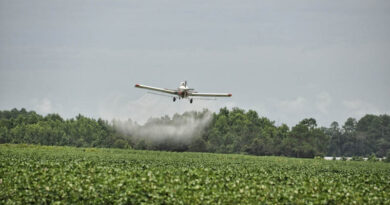Federal Court Halts Spraying of Monsanto’s Dicamba Pesticide Across Millions of Acres of Cotton, Soybeans
08 February 2024, Arizona: In a sweeping victory for family farmers and dozens of endangered plants and animals, a federal court in Arizona revoked approval of the notoriously volatile, weed-killing pesticide dicamba.
The drift-prone pesticide has damaged millions of acres of crops and wild plants every year since the Environmental Protection Agency (EPA) first approved it in 2017 for spraying on cotton and soybean crops genetically engineered by Monsanto (now Bayer) to survive what would otherwise be a deadly dose. Today’s ruling by the U.S. District Court of Arizona in Tucson overturns the EPA’s 2020 reapproval of the pesticide, which included additional application restrictions that have nonetheless failed to prevent the ongoing drift damage.
“This is a vital victory for farmers and the environment,” said George Kimbrell, Center for Food Safety’s (CFS) legal director and counsel in the case. “Time and time again, the evidence has shown that dicamba cannot be used without causing massive and unprecedented harm to farms as well as endangering plants and pollinators. The Court today resoundingly re-affirmed what we have always maintained: the EPA’s and Monsanto’s claims of dicamba’s safety were irresponsible and unlawful.”
Since dicamba was approved for “over-the-top” spraying its use has increased twentyfold. The EPA estimates 65 million acres (two-thirds of soybeans and three-fourths of cotton) are dicamba-resistant, with roughly half that acreage sprayed with dicamba, an area nearly the size of Alabama. Much of the unsprayed crops are planted “defensively” by farmers to avoid dicamba drift damage.
In today’s decision, the court cancelled dicamba’s over-the-top use, holding that EPA violated FIFRA’s public input requirement prior to the approval. This violation is “very serious,” according to the court, especially because the Ninth Circuit previously held EPA failed to consider serious risks of over-the-top dicamba in issuing the prior registration. The court outlined the massive damage to stakeholders that were deprived of their opportunity to comment, such as growers that do not use over-the-top dicamba and suffered significant financial losses and states that repeatedly reported landscape-level damage yet, in the same 2020 decision, lost the ability to impose restrictions greater than those imposed by the federal government without formal legislative and/or rulemaking processes. As a result, the court found “the EPA is unlikely to issue the same registrations” again after taking these stakeholders’ concerns into account.
The court also criticized the EPA’s assessment of the 2020 registrations’ widespread harms. Monsanto and the EPA claimed this “over-the-top” new use of dicamba would not cause harm due to its new restrictions on use. But the court found the EPA’s “circular approach to assessing risk, hinging on its high confidence that control measures will all but eliminate offsite movement, [led] to its corresponding failure to assess costs from offsite movement.” And instead, just as independent researchers had warned, the restrictions failed, and dicamba continued to vaporize and drift.
“I hope the court’s emphatic rejection of the EPA’s reckless approval of dicamba will spur the agency to finally stop ignoring the far-reaching harm caused by this dangerous pesticide,” said Nathan Donley, environmental health science director at the Center for Biological Diversity. “Endangered butterflies and bee populations are going to keep tanking if the EPA keeps twisting itself into a pretzel to approve this product just to appease the pesticide industry.”
“We are grateful that the court held the EPA and Monsanto accountable for the massive damage from dicamba to farmers, farmworkers and the environment, and halted its use,” said Lisa Griffith of the National Family Farm Coalition. “The pesticide system that Monsanto sells should not be sprayed as it cannot be sprayed safely.”
“Every summer since the approval of dicamba, our farm has suffered significant damage to a wide range of vegetable crops,” said Rob Faux, a farmer and communications manager at Pesticide Action Network. “Today’s decision provides much needed and overdue protection for farmers and the environment.”
Background
This is the second time a federal court has found that the EPA unlawfully approved dicamba. An earlier case resulted in a court of appeals overturning the agency’s prior approval of the pesticide. The EPA reapproved the same uses of the pesticide in 2020, leading to the current lawsuit.
Today’s ruling outlaws dicamba products sprayed over emerged soybeans and cotton crops that are genetically engineered to withstand the spray. Since 2017 the pesticide has caused drift damage to millions of acres of non-genetically engineered soybeans as well as to orchards, gardens, trees and other plants on a scale unprecedented in the history of U.S. agriculture.
Dozens of imperiled species, including pollinators like monarch butterflies and rusty patched bumblebees, are also threatened by the pesticide.
The EPA admitted in a 2021 report that its application restrictions to limit dicamba’s harm had failed and the pesticide was continuing to cause massive drift damage to crops.
The U.S. Department of Agriculture estimates that up to 15 million acres of soybeans have been damaged by dicamba drift. Beekeepers in multiple states have reported sharp drops in honey production due to dicamba drift suppressing the flowering plants their bees need for sustenance.
The plaintiffs are National Family Farm Coalition, Pesticide Action Network, Center for Food Safety and the Center for Biological Diversity. They are represented by legal counsel from the Center for Food Safety and the Center for Biological Diversity.
Also Read: Best Agrolife to manufacture a combination of Trifloxystrobin, Thiamethoxam, and Thiophanate Methyl under the brand name Warden Extra
(For Latest Agriculture News & Updates, follow Krishak Jagat on Google News)















